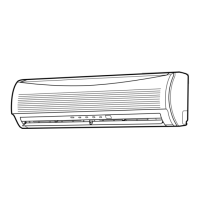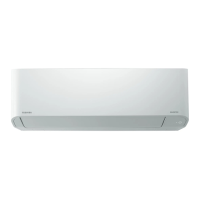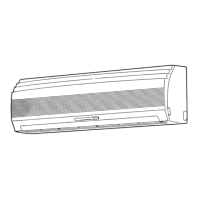– 29 –
Item
6. Release
protective
control by
temperature of
indoor heat
exchanger
Operation flow and applicable data, etc.
<In cooling/dry operation>
(Freeze proof for indoor heat exchanger)
In cooling/dry operation, the sensor of indoor heat ex-
changer detects evaporation temperature of the refrigerant
and decreases No. of revolution of the compressor so that
temperature of the heat exchanger does not exceed the
specified value, in order to enable the compressor to
operate in the range of the specified temperature value.
Description
1) When temperature of the indoor
heat exchanger is down to 5°C or
lower, No. of revolution of the
compressor is decreased.
(P zone)
2) When temperature of the indoor
heat exchanger is up in the
range from 6°C to 7°C, No. of
revolution of the compressor is
held. (Q zone)
3) When temperature of the indoor
heat exchanger is up to 7°C or
higher, the capacity control
operation returns to the usual
control in cooling operation.
(R zone)
1) When temperature of the indoor
heat exchanger is up in the
range from 52°C to 55°C, No. of
revolution of the compressor is
held. (Q zone)
When temperature of the indoor
heat exchanger is down in the
range from 48°C to 55°C, No. of
revolution of the compressor is
held. (Q zone)
2) When temperature of the indoor
heat exchanger is up to 55°C or
higher, No. of revolution of the
compressor is decreased.
(P zone)
3) When temperature of the indoor
heat exchanger is up to 52°C or
lower, or when it is down to 48°C
or lower, the capacity control
operation returns to the usual
control in heating operation.
(R zone)
<In heating operation>
(Overpressure proof for refrigerating cycle)
In heating operation, the sensor of indoor heat exchanger
detects condensation temperature of the refrigerant and
decreases No. of revolution of the compressor so that
temperature of the heat exchanger does not exceed the
specified value, in order to enable the compressor to
operate in the range of the specified temperature value.
7˚C
6˚C
5˚C
R
Q
P
55˚C
52˚C
48˚C
R
Q
R
Usual cooling capacity control
Decreases No. of revolution of compressor
Indoor heat exchanger temperature
When the value in
Q zone, No. of
revolution of the
compressor is held.
Usual cooling capacity control
Decreases No. of revolution of compressor
Indoor heat exchanger temperature
When the value in
Q zone, No. of
revolution of the
compressor is held.

